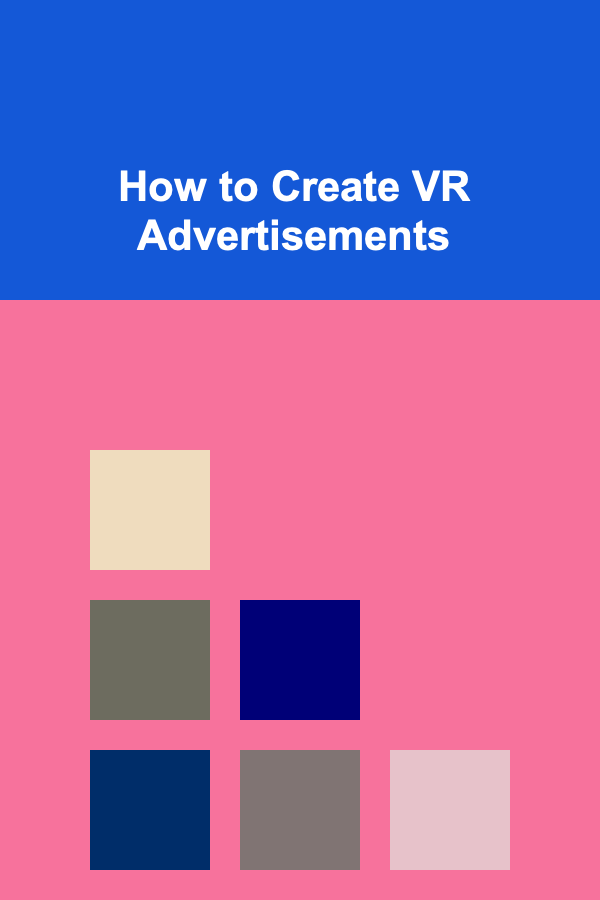
How to Create VR Advertisements
ebook include PDF & Audio bundle (Micro Guide)
$12.99$9.99
Limited Time Offer! Order within the next:

Virtual Reality (VR) has rapidly transformed various industries by offering immersive experiences that captivate audiences in new and dynamic ways. Among the sectors benefiting from VR technology, advertising has emerged as one of the most exciting areas for innovation. Traditional forms of advertising, such as print, TV, and digital ads, are no longer enough to engage a tech-savvy audience. With VR advertisements, brands can craft unique, interactive, and memorable experiences that leave a lasting impression.
This article delves into the process of creating VR advertisements, covering everything from the fundamentals of VR to the creative and technical aspects involved in producing effective VR ad content.
What is VR Advertising?
VR advertising is a form of marketing where brands create immersive, 3D experiences that engage users in a simulated environment. Unlike traditional ads, which are often passive, VR advertisements offer an interactive experience that allows users to engage with the brand in a fully immersive and often customizable way. This type of advertising leverages the power of VR technology to transport users to another world, whether it's a virtual store, a product demonstration, or an experiential journey that showcases the brand's values and mission.
With VR advertising, the audience can interact with the environment, explore virtual spaces, and experience the product or service in a way that goes beyond the capabilities of conventional media. This makes VR a powerful tool for storytelling and brand engagement.
Why VR Advertising Works
- Immersive Experience: VR creates a sense of presence, meaning that users feel like they are physically inside the virtual world. This heightened immersion can lead to stronger emotional engagement, as it activates multiple senses.
- Increased Engagement: VR offers interactive experiences where users can control their actions within the environment, creating a sense of autonomy that draws them deeper into the content. This interactivity leads to longer engagement times compared to traditional forms of advertising.
- Memorability: People tend to remember experiences that are out of the ordinary, and VR offers exactly that. With its immersive nature, VR advertising stands out in the consumer's mind and has the potential to create a stronger brand recall.
- Appeal to Younger Audiences: Younger demographics, particularly Millennials and Gen Z, are highly attracted to new technologies and immersive experiences. VR ads allow brands to connect with these tech-savvy consumers who appreciate cutting-edge, interactive media.
- Analytics and Data: VR environments can track users' behaviors in real-time, offering valuable insights into their actions and interactions. Brands can gather data about what elements of the experience the audience interacts with the most, helping to refine future advertisements.
Key Steps in Creating a VR Advertisement
Creating a successful VR advertisement requires careful planning, creative thinking, and technical expertise. The process involves several stages, from conceptualizing the idea to producing and distributing the final content.
1. Define Your Objectives
Before diving into the creative process, it's essential to define the goals of the VR advertisement. Ask yourself the following questions:
- What message do you want to convey? Determine the key message or emotion you want the user to take away from the experience. Whether it's showcasing a product, telling a story, or creating brand awareness, knowing your message is the first step in crafting the VR ad.
- Who is your target audience? Understanding who will be experiencing the ad will help you design a VR experience that speaks directly to their needs and interests. Consider factors such as age, gender, geographic location, and preferences.
- What action do you want the user to take? Be clear about the call to action (CTA). Whether it's purchasing a product, signing up for a service, or simply sharing the ad, the user's next step should be clear and achievable within the VR experience.
Defining these objectives will guide the development of your VR ad and ensure that it aligns with the overall marketing strategy.
2. Conceptualize the Experience
Once you have a clear understanding of your goals, you can begin conceptualizing the VR experience. Unlike traditional advertisements, VR ads provide an opportunity to think outside the box, offering interactive elements that engage the user. During this stage, the following aspects should be considered:
- Storytelling: Think about how you can use VR to tell a compelling story. A well-crafted narrative can help establish an emotional connection with the audience. Consider creating a scenario where the user becomes an active participant in the story, allowing them to explore different outcomes based on their decisions.
- Environment Design: VR allows you to create any environment imaginable. Whether it's a futuristic city, a serene beach, or an interactive virtual product demo, the environment should be designed with the target audience in mind. The goal is to immerse the user in a space where the brand message feels natural and intuitive.
- Interactivity: One of the unique aspects of VR advertising is the level of interactivity it offers. Design the experience so that users can engage with the virtual environment. This could be through exploring, manipulating objects, making choices, or interacting with characters. The key is to make the experience enjoyable and meaningful for the user.
- Emotional Engagement: VR has the ability to evoke deep emotions. Think about how your brand can use this immersive medium to foster positive feelings such as excitement, nostalgia, or happiness. Emotional connections are powerful tools in driving consumer loyalty.
3. Choose the Right VR Platform
The next step is selecting the appropriate VR platform for your advertisement. There are several VR devices and platforms available, each offering different levels of immersion and user experiences. Some of the popular VR platforms include:
- Oculus Quest (Meta Quest): A standalone VR headset that is highly popular among consumers. It's wireless, affordable, and provides high-quality experiences, making it ideal for mass consumer engagement.
- HTC Vive: Known for its high-quality graphics and immersive experience, the HTC Vive is often used for more complex VR experiences, including interactive advertisements in retail settings.
- PlayStation VR: If your target audience is gamers, PlayStation VR could be an excellent choice. It's accessible and provides an immersive environment for video game enthusiasts.
- PC VR (Windows Mixed Reality, Oculus Rift): For more advanced VR ads, you might consider developing for high-end devices connected to powerful PCs, which offer superior graphics and computing power.
Your choice of platform will depend on the target audience's preferences, the complexity of the ad, and the type of VR experience you're designing. Make sure the ad is optimized for the chosen platform to ensure a smooth, enjoyable experience for users.
4. Production Process
The production process of a VR ad is similar to that of traditional video production but involves additional complexity due to the immersive nature of the medium. Here's a breakdown of the key steps:
- Pre-production: This phase involves planning the logistics of the shoot, designing the environment, and creating the storyboards. It's essential to map out the user's journey within the VR ad and ensure that the narrative flows seamlessly.
- 3D Modeling and Animation: In VR, everything is rendered in 3D. Designers will need to create 3D models of the objects, products, or environments that will appear in the experience. The more detailed the models and animations, the more immersive and lifelike the VR ad will feel.
- User Interaction Design: Interactive elements, such as buttons, levers, or in-game objects, need to be carefully designed to ensure they are intuitive and easy to use. User actions should be rewarded or acknowledged within the VR environment to create a sense of accomplishment.
- Audio Design: Sound plays a crucial role in creating immersion. 3D audio techniques can help enhance the experience by providing spatial sounds that match the user's movements. Background music, sound effects, and voiceovers can all contribute to the overall atmosphere.
- Testing: Testing the VR ad is critical to ensure it works smoothly across different devices and platforms. Perform thorough user testing to ensure that the interactive elements function as intended and that the experience is enjoyable for the audience.
5. Launch and Distribution
After producing the VR advertisement, the next step is to launch and distribute it. Depending on your objectives, this could involve releasing the VR ad through various channels:
- VR Headsets: Distribute the VR ad directly to users' devices via VR app stores, such as Oculus Store or PlayStation Store.
- WebVR: For more accessible VR experiences, consider using WebVR, which allows users to experience VR ads directly through web browsers using compatible headsets or even mobile devices.
- Social Media and Events: Host virtual events or social media campaigns where users can experience the VR ad. VR can also be used for virtual brand activations at events or conferences.
Consider how to make the experience as accessible as possible for your target audience, whether through partnerships, influencer marketing, or content marketing.
Challenges in VR Advertising
While VR advertising offers exciting possibilities, it also comes with its own set of challenges:
- Cost: The production of VR ads can be expensive due to the need for specialized equipment, skilled personnel, and complex development processes.
- User Accessibility: Not all consumers own VR headsets, which limits the reach of VR advertising. Additionally, the technology is still relatively new, meaning there may be a learning curve for users who are unfamiliar with VR.
- Technical Hurdles: VR content must be optimized for different platforms and devices, and it must also deliver high-quality performance. Poorly optimized VR ads can lead to technical issues that disrupt the experience.
- Content Fatigue: As VR advertising grows in popularity, there is a risk of oversaturation. To stand out, brands need to focus on innovation and continuously offer fresh, engaging experiences.
Conclusion
Creating VR advertisements is an exciting yet challenging process that requires a combination of creativity, technical expertise, and a clear understanding of your target audience. By defining clear objectives, conceptualizing immersive experiences, and producing high-quality content, brands can leverage VR advertising to engage consumers in groundbreaking ways. With VR's immersive capabilities, advertisers have the opportunity to craft memorable experiences that resonate with audiences and drive long-term brand loyalty.

How to Design a Functional and Space-Efficient Mudroom
Read More
How to Develop a Note-Taking System for Virtual Lessons
Read More
How to Increase Home Security Without Sacrificing Aesthetics
Read More
How to Increase the Value of Your Rental Property Through Renovations
Read More
How to Understand Blockchain Forks
Read More
How To Cultivate an Abundance Mindset
Read MoreOther Products

How to Design a Functional and Space-Efficient Mudroom
Read More
How to Develop a Note-Taking System for Virtual Lessons
Read More
How to Increase Home Security Without Sacrificing Aesthetics
Read More
How to Increase the Value of Your Rental Property Through Renovations
Read More
How to Understand Blockchain Forks
Read More